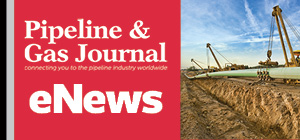Thawing Permafrost Could Threaten Sections of Trans Alaska Pipeline’s Foundation
(P&GJ) — The Trans-Alaska Pipeline is in danger due to thawing permafrost that supports an elevated section of the pipeline, NBC news reported.

The 800-mile, 48-inch interstate oil pipeline is one of the biggest in the world. It can transport 2,200 bpd, rungs from the Prudhoe Bay to the Valdez Marine Terminal, where oil is loaded onto tankers for shipment to market, and about 420 miles of the pipeline is elevated on 78,000 vertical support members due to permafrost, according to Global Energy Infrastructure data.
Michelle Egan, a spokeswoman for Alyeska Pipeline Service Co., an association of oil companies that operates the pipeline, declined to comment on a thawing slope of permafrost where an 810-foot section of the pipeline is secured, but told NBC news that “permafrost changes were anticipated during the original design.”
The thawing is causing some braces holding up the pipeline to twist and bend, NBC reported, and in response, the Alaska Department of Natural Resources approved the use of about 100 thermosyphons — tubes that suck heat out of permafrost — to keep the frozen slope in place and prevent further damage.
Alyeska sought permission in February 2020 to install the thermosyphons and confirmed that thawing permafrost posed a threat, NBC said.
During the “last few decades,” permafrost temperatures have warmed about 3.5 degrees Fahrenheit, and Alaska’s temperature is projected to increase 2 to 4 degrees by the middle of the century, according to the NBC report. Nature Climate Change journal projects 1.5 million square miles of permafrost could be lost to thawing for every 2 degree temperature increase.
Related News
Related News

- Kinder Morgan Proposes 290-Mile Gas Pipeline Expansion Spanning Three States
- Three Killed, Two Injured in Accident at LNG Construction Site in Texas
- Tallgrass to Build New Permian-to-Rockies Pipeline, Targets 2028 Startup with 2.4 Bcf Capacity
- TC Energy Approves $900 Million Northwoods Pipeline Expansion for U.S. Midwest
- U.S. Moves to Block Enterprise Products’ Exports to China Over Security Risk
- U.S. Pipeline Expansion to Add 99 Bcf/d, Mostly for LNG Export, Report Finds
- Enbridge Adds Turboexpanders at Pipeline Sites to Power Data Centers in Canada, Pennsylvania
- Great Basin Gas Expansion Draws Strong Shipper Demand in Northern Nevada
- Cheniere Seeks FERC Approval to Expand Sabine Pass LNG Facility
- Heath Consultants Exits Locate Business to Expand Methane Leak Detection Portfolio




Comments